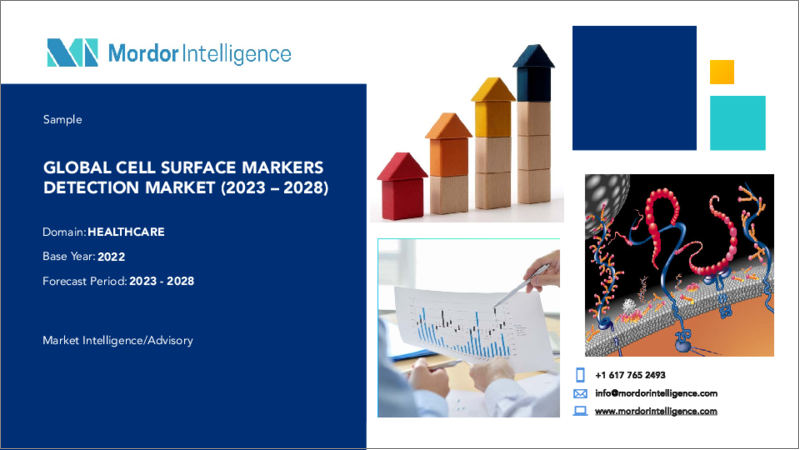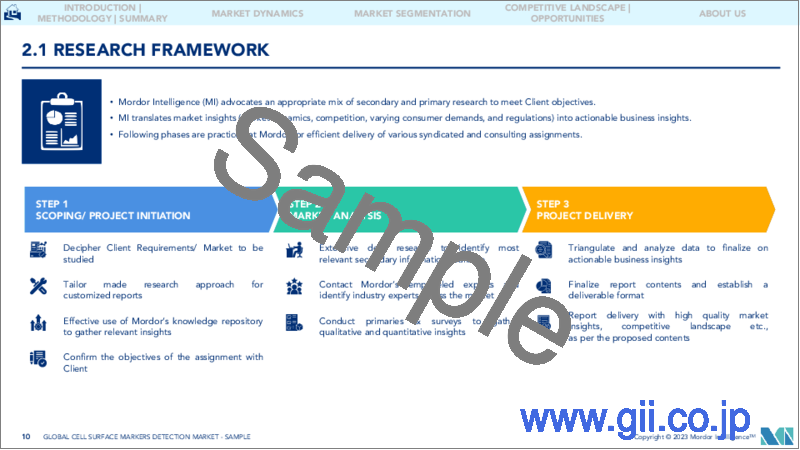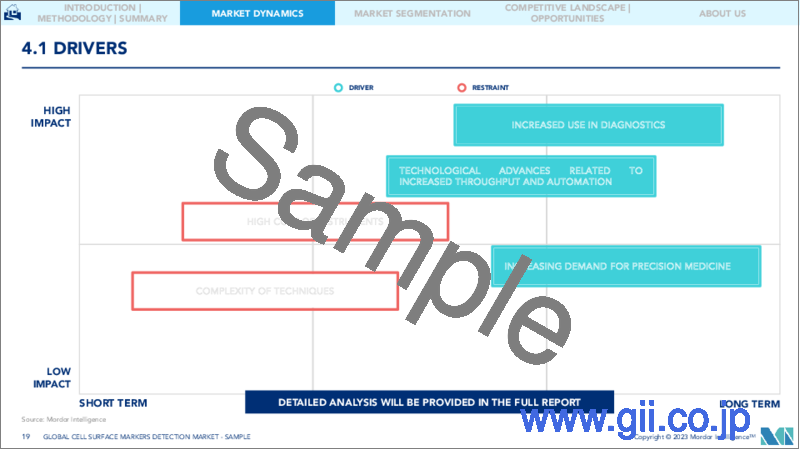|
|
市場調査レポート
商品コード
1190258
細胞表面マーカー検出市場- 成長、動向、予測(2023年-2028年)Cell Surface Markers Detection Market - Growth, Trends, and Forecasts (2023 - 2028) |
||||||
|
● お客様のご希望に応じて、既存データの加工や未掲載情報(例:国別セグメント)の追加などの対応が可能です。 詳細はお問い合わせください。 |
|||||||
| 細胞表面マーカー検出市場- 成長、動向、予測(2023年-2028年) |
|
出版日: 2023年01月18日
発行: Mordor Intelligence
ページ情報: 英文 114 Pages
納期: 2~3営業日
|
- 全表示
- 概要
- 目次
細胞表面マーカー検出市場は、予測期間である2022-2027年にCAGR8.2%を記録すると予測されます。
COVID-19のパンデミックは、市場に大きな影響を与えると予想されます。細胞表面マーカーとは、細胞膜に付着している炭水化物やタンパク質を指し、細胞表面マーカーが細胞間シグナル伝達において重要な役割を果たすことを可能にしています。COVID-19抗体と細胞表面マーカーとの相互作用を利用した研究が多く行われています。例えば、2021年2月、Frontiers in Immunologyに掲載された「COVID-19 Impairs Immune Response to Candida Albicans」という研究論文では、COVID-19患者の単球上の細胞表面マーカー発現を健常対照者と比較し、調査しています。その結果、COVID-19患者では、真菌の二次感染率が上昇していることが判明しました。COVID-19患者の多くは免疫力が低下しているため,二次的な真菌感染症の発生率が高くなります。このように、真菌感染症の研究に細胞表面マーカーを使用することは、市場の成長を後押しすると期待されます。このような取り組みは、病気に対する理解を深め、治療法を見つけるための革新的な方法につながるものです。COVID-19の効果を研究するために細胞表面マーカーが使用される、そのような研究プロジェクトが世界中で増えています。したがって、このような新興国市場の開拓が市場の成長を後押しすると期待されます。
市場の成長を促す主な要因としては、精密医療に対する需要の高まり、診断薬の使用の増加、スループット向上と自動化に関連する技術的進歩などが挙げられます。例えば、サイトケラチン断片21-1やEGFR遺伝子変異など、肺がんにおいて過剰発現している細胞表面マーカーは200以上確認されています。これらのマーカーを通じて、血液中の腫瘍細胞の存在を検出する診断法が用いられています。世界のがん患者数の増加は、バイオマーカーの需要にプラスの影響を与え、細胞表面マーカー検出市場の成長を押し上げると予想されます。例えば、Globocan 2020レポートによると、2020年の乳がん患者総数は2,261,419人であり、次いで肺がん患者(2,206,771人)、前立腺がん患者(1,414,259人)です。このように、世界的に肺の有病率が高まっていることが、予測期間中の市場成長を支えています。
精密医療は、個別化医療とも呼ばれ、個々の患者の特性に合わせて投与されるテーラーメード医療のことです。これらの医薬品は、個々の患者にとって最も効果的な治療法に向けてヘルスケアの意思決定を導きます。細胞表面マーカーは、細胞の識別と分類を助けるモノグラムとして機能するため、がん細胞の表面に発現するタンパク質は、特定の腫瘍タイプのマーカーとして機能します。この分子識別は、病気の診断、病気に対する直接的な治療法の発見、創薬に役立つため、市場の成長を後押ししています。多くの企業が市場準備に携わっており、これが市場の成長を後押しすると思われます。例えば、Becton, Dickinson and Company社は、研究機関向けにBD Lyoplate Human Cell Surface Marker Screening Panelを製造しています。これは、初代細胞や組織、細胞株のスクリーニングに使用することができます。フローサイトメトリーやバイオイメージング技術のプラットフォームと互換性があります。このような幅広い用途に対応した革新的な製品は、市場の成長を後押しすると期待されます。
細胞表面マーカー検出の市場動向
フローサイトメトリーセグメントが最も速い速度で成長すると予想される
フローサイトメトリーの技術は、集団内の異なる細胞タイプを識別するために使用されます。フローサイトメトリーでは、単一細胞に強く集光されたレーザーが照射されます。サンプルには、関心のある細胞表面マーカーに特異的な抗体を加え、細胞と相互作用させる時間を設けます。この抗体には、さまざまな波長で発光する性質を持つ蛍光色素が結合しています。そして、蛍光色素を励起し、細胞集団にレーザーを照射して放出される光を捕らえます。その後、一連のヒストグラムとドットプロットからなるゲーティング戦略を用いて、細胞をマーカーに基づくサブ集団に分割することができます。細胞表面に発現する細胞表面マーカーは、蛍光標識抗体で標識し、フローサイトメトリーで解析すると、細胞のサブタイプや機能を定義することができます。
2021年9月にStar Protocolに掲載された「Flow cytometry detection of surface and intracellular antigens in pancreas from a single mouse embryo」という研究によると、フローサイトメトリーを用いて単一胚膵臓の細胞表面タンパク質定量解析が行われたそうです。レポータータンパク質、細胞表面タンパク質、細胞内タンパク質を一度に検出、生物学的変異の発見を可能にすると同時に、必要な動物数を減らすことができます。このように、フローサイトメトリーによる細胞の検出は、上記のような利点があることから、同分野の市場拡大が予想されます。
フローサイトメトリーの役割は、細胞表面マーカーを用いた原発性免疫不全症を含む免疫系疾患の研究にも広がっています。例えば、フローサイトメトリーによる細胞表面染色は、リンパ球のクローナリティを調査するためによく用いられます。T細胞のクローナリティの研究は、制限されたT細胞に関連する原発性免疫不全障害を評価するために特に有用です。フローサイトメトリー」と題された研究によると、「Flow cytometry:2019年にJACI Onlineに掲載された「Surface Markers and beyond」によると、臨床検査法としてのフローサイトメトリーの応用は、細胞表面マーカーの同定から細胞内タンパク質の特性評価へと発展し、免疫機能の評価と免疫疾患の特性評価および診断に複数の異なるアプローチを提供するようになっています。フローサイトメトリーは、がんの診断に広く使用されています。人間開発指数(HDI)の高い国々は、ヘルスケアに多くの投資をしています。したがって、より多くのがん診断検査が実施され、これらの国ではより多くのがん症例が発見されており(国際がん研究機関、2020年)、これが市場の成長を後押しすると思われます。
しかし、主要な市場プレーヤーによる製品発売の増加が、このセグメントを後押しすると予想されます。例えば、2020年6月、Sysmex America Inc.は、ラボに幅広いアプリケーションのための柔軟性と効率性の向上を提供するXF-1600フローサイトメーターの発売を発表しました。
したがって、上記のすべての要因は、予測期間にわたってセグメントの成長を促進すると予想されます。
北米が市場を独占し、予測期間中もそのシェアを維持すると予想される
北米地域は、細胞表面マーカーにおいて最大の市場です。疾病診断における用途の急速な拡大、確立された研究機関の存在、バイオテクノロジー産業が、市場規模拡大の主な要因となっています。北米の細胞表面マーカー検出市場は現在米国が支配しており、今後も数年間はその牙城が続くと予想されます。高いヘルスケア支出、高い技術適応率、正確でタイムリーな診断への注目の高まりが、米国の市場成長を後押ししています。
米国にはこの分野で事業を展開する企業が多く、予測期間中、同国の需要は堅調に推移するものと思われます。米国に拠点を置く企業には、Nexcelom Bioscience LLC、Cofactor Genomics Inc.、Abbott Laboratories、Beckman Coulter Inc.などがあります。これらの企業による製品上市の増加は、市場の成長を後押しするものと思われます。例えば、2020年11月、米国の研究・臨床診断会社であるBio-Rad Laboratories Inc.は、フローサイトメトリー用に特別に開発された3種類のStarBright Dyesを発売しました。この色素には、StarBright Blue 700、StarBright Violet 440、StarBright Violet 610があり、これらはバイオラッドのフロー抗体と結合した蛍光ナノ粒子で、最大限の輝度と向上した分解能を提供します。市場検知における表面タンパク質の検出に使用することができます。さらに、2020年10月、ベクトン、ディキンソンアンドカンパニーは、統合されたBD FACSDuetサンプル調製システムを備えたBD FACSLyricフローサイトメーターについて米国FDAから510(k)許可を受けたことを発表しました。主要企業によるこうした取り組みは、市場の成長を後押しする可能性が高いです。
このように、前述のすべての要因が、予測期間中の市場成長を後押しすると予想されます。
細胞表面マーカー検出市場の競合分析
細胞表面マーカー検出市場は、Becton, Dickinson and Company、Nihon Kohden Corporation、Luminex Corporation、Sysmex Corporation、Thermo Fisher Scientific Incなど、特に機器面で多くの世界プレーヤーで構成されています。しかし、試薬や消耗品などニッチな分野では、いくつかのバイオベンチャーが活躍しています。現在、さらなる統合の動きが進んでおり、プレイヤーは主に新技術の獲得に注力しています。また、一部の主要な市場参入企業は、製品ラインやブランドの買収に注力しています。
その他の特典
- エクセル形式の市場予測(ME)シート
- アナリストによる3ヶ月間のサポート
目次
第1章 イントロダクション
- 調査の前提条件と市場の定義
- 調査対象範囲
第2章 調査手法
第3章 エグゼクティブサマリー
第4章 市場力学
- 市場概要
- 市場促進要因
- 診断分野での利用拡大
- スループット向上と自動化に関する技術的進歩
- プレシジョンメディシンへの需要の高まり
- 市場抑制要因
- 機器の高コスト
- 技術の複雑さ
- ポーターのファイブフォース分析
- 新規参入業者の脅威
- 買い手/消費者の交渉力
- 供給企業の交渉力
- 代替品の脅威
- 競争企業間の敵対関係
第5章 市場セグメンテーション(金額別市場規模-USD Million)
- 製品名
- フローサイトメトリー
- 血液分析装置
- 細胞イメージングシステム
- 試薬・キット
- その他の製品
- 用途
- 疾病の診断と同定
- 研究・創薬
- その他の用途
- 地域別
- 北米
- 米国
- カナダ
- メキシコ
- 欧州
- ドイツ
- 英国
- フランス
- イタリア
- スペイン
- その他の欧州地域
- アジア太平洋地域
- 中国
- 日本
- インド
- オーストラリア
- 韓国
- その他アジア太平洋地域
- 中東・アフリカ地域
- GCC
- 南アフリカ共和国
- その他の中東・アフリカ地域
- 南米地域
- ブラジル
- アルゼンチン
- その他の南米地域
- 北米
第6章 競合情勢
- 企業プロファイル
- Abbott Laboratories
- Danaher Corporation(Beckman Coulter Inc.)
- Becton, Dickinson and Company
- Bio Rad Laboratories Inc.
- F. Hoffmann-La Roche Ltd
- Diasorin SpA(Luminex Corporation)
- Nihon Kohden Corporation
- Qiagen NV
- Siemens Healthineers
- Thermo Fisher Scientific Inc.
- Grifols SA
- Nexcelom Bioscience LLC
- IVD Medical Holding Limited(Immucor Inc.)
- Agilent Technologies Inc.
- Sysmex Corporation
第7章 市場機会と今後の動向
The cell surface markers detection market is estimated to register a CAGR of 8.2% during the forecast period, 2022-2027.
The COVID-19 pandemic is expected to have a significant impact on the market. Cell surface markers refer to carbohydrates and proteins that are attached to the cell membrane, allowing cell surface markers to play a crucial role in intercellular signaling. Many research projects are being carried out that involve the interaction of COVID-19 antibodies with cell surface markers. For example, in February 2021, a research article titled 'COVID-19 Impairs Immune Response to Candida Albicans', published in Frontiers in Immunology, studied and compared the cell surface marker expression on the monocytes of COVID-19 patients with healthy controls. The study found an increased rate of fungal co-infections in COVID-19 patients. The rate of secondary fungal infections increases in many COVID-19 patients due to their decreased immunity. Thus, the use of cell surface markers to study fungal infection is expected to boost the market's growth. Such initiatives help drive a better understanding of the disease, leading to innovative ways to find a cure. More such research projects are being conducted worldwide, where cell surface markers are used to study the effect of COVID-19. Thus, such developments are expected to boost the market's growth.
The major factors driving the market's growth include the increasing demand for precision medicine, increased use of diagnostics, and technological advances related to increased throughput and automation. For example, over 200 cell-surface markers have been identified as being overexpressed in lung cancers, including cytokeratin fragment 21-1 and EGFR gene mutation. Diagnostic procedures are used to detect the presence of tumor cells in the blood through these markers. An increase in the number of cancer cases worldwide is expected to positively impact the demand for biomarkers, thus boosting the growth of the cell surface markers detection market. For instance, according to the Globocan 2020 report, the total number of breast cancer cases in 2020 was 2,261,419, followed by lung cancer cases (2,206,771) and prostate cancer cases (1,414,259). Thus, growing prevalence of the lung across across globe supports the market growth over the forecast period.
Precision medicine also known as personalized medicine, is the tailored medication given according to the individual patient's characteristics. These medicines guides healthcare decisions towards a most effective treatment for an individual patient. Since cell surface markers serve as monograms to help identify and classify cells, the proteins expressed on the surface of cancerous cells serve as markers of specific tumor types. This molecule identification helps in disease diagnoses, finding direct treatment for the disease, and drug discovery, thus boosting the market's growth. Many companies are involved in market preparation, which is likely to boost the market's growth. For instance, Becton, Dickinson and Company manufactures the BD Lyoplate Human Cell Surface Marker Screening Panel for research laboratories. It can be used for screening primary cells or tissues and cell lines. It is compatible with flow cytometry and bioimaging technology platforms. Such innovative products with a wide variety of applications are expected to boost the market's growth.
Cell Surface Markers Detection Market Trends
Flow Cytometry Segment is Expected to Grow at the Fastest Rate
The technique of flow cytometry is used to identify different cell types in a population. Single cells are subjected to an intensely focused laser during the procedure. In a sample, interest-related cell surface markers-specific antibodies are added and given time to interact with the cells. Fluorochromes, which have the property of emitting light at various wavelengths, are coupled with these antibodies. The fluorochromes are then excited and the light emitted is captured as the cell population is then passed through a laser. The cells can then be divided into subpopulations based on the markers by using a gating strategy, which consists of a series of histograms and dot plots. Cell surface markers expressed on the cell surface can define cell subtypes and function when they are labeled with fluorescent-labeled antibodies and analyzed by flow cytometry.
According to the study titled "Flow cytometry detection of surface and intracellular antigens in pancreas from a single mouse embryo" published in the Star Protocol in September 2021, Flow cytometry was used to perform a quantitative cell surface protein analysis on a single embryonic pancreas. Detection of reporter, cell surface, and intracellular proteins all at the same time. Allows for the discovery of biological variation while also reducing the number of animals required. Thus, due to above mentned benefits of the flow cytometry in detection of cell, surgace markets anticipated to boost the segment growth.
The role of flow cytometry has broadened to include the study of immune system disorders, including primary immunodeficiency disorders, by using cell surface markers. For instance, cell-surface staining using flow cytometry is often used to investigate lymphocyte clonality. T-cell clonality studies are particularly useful to evaluate primary immunodeficiency disorders associated with a restricted T-cell. According to a study titled 'Flow cytometry: Surface markers and beyond' published in JACI Online in 2019, the application of flow cytometry as a clinical laboratory method evolved from the identification of cell-surface markers to characterizing intracellular proteins and providing multiple different approaches to assess immune function and characterizing and diagnosing immunologic disorders. Flow cytometry is used extensively in diagnosing cancer. Countries with a high Human Development Index (HDI) invest more in healthcare. Thus, more cancer diagnostic tests are conducted, and more cancer cases are detected in these countries (International Agency for Research on Cancer, 2020), which will likely boost the market's growth.
However, increasing product launches by the key market players anticipated to boost the segment. For Instance, In June 2020, Sysmex America Inc. announced the launch of its XF-1600 flow cytometer that provides laboratories with improved flexibility and efficiency for a wide range of applications.
Thus, all above mentioned factors expected to drive the segment growth over the forecast period.
North America Dominates the Market and is Expected to Retain its Market Share During the Forecast Period
The North American region is the largest market for cell surface markers. Rapidly growing applications in disease diagnostics, the presence of well-established research institutions, and the biotech industry are the primary factors behind the large market size. United States currently dominates the cell surface marker detection market in North America, and it is expected to continue its stronghold for a few more years. High healthcare expenditure, a high technological adaptation rate, and an increasing focus on precise and timely diagnostics are driving the market growth in United States.
United States has many companies operating in this sector, owing to which demand from the country is expected to be robust during the forecast period. Some US-based companies in the market include Nexcelom Bioscience LLC, Cofactor Genomics Inc., Abbott Laboratories, and Beckman Coulter Inc. The increased product launches by these players are expected to boost the market growth. For example, in November 2020, Bio-Rad Laboratories Inc., a US-based research and clinical diagnostic company, launched three StarBright Dyes specifically developed for flow cytometry. The dyes include StarBright Blue 700, StarBright Violet 440, and StarBright Violet 610, and they are fluorescent nanoparticles conjugated to Bio-Rad's flow antibodies, providing maximal brightness and improved resolution. They can be used for detecting surface proteins in market detection. Additionally, in October 2020, Becton, Dickinson and Company announced that it received 510(k) clearance from the US FDA for BD FACSLyric Flow Cytometer with the integrated BD FACSDuet Sample Preparation System.Such initiatives by major players are likely to boost the market's growth.
Thus, all aforementioned factors expected to boost the market growth over the forecast period.
Cell Surface Markers Detection Market Competitive Analysis
The cell surface markers detection market consists of many global players, especially on the instrument front, including Becton, Dickinson and Company, Nihon Kohden Corporation, Luminex Corporation, Sysmex Corporation, and Thermo Fisher Scientific Inc. However, several biotech start-ups are active in the reagent, consumables, and other niche fields. There is an ongoing trend of further consolidation, with players mainly focusing on acquiring new technology. Some key market participants are also focusing on acquiring product lines and brands.
Additional Benefits:
- The market estimate (ME) sheet in Excel format
- 3 months of analyst support
TABLE OF CONTENTS
1 INTRODUCTION
- 1.1 Study Assumptions and Market Definition
- 1.2 Scope of the Study
2 RESEARCH METHODOLOGY
3 EXECUTIVE SUMMARY
4 MARKET DYNAMICS
- 4.1 Market Overview
- 4.2 Market Drivers
- 4.2.1 Increased Use in Diagnostics
- 4.2.2 Technological Advances Related to Increased Throughput and Automation
- 4.2.3 Increasing Demand for Precision Medicine
- 4.3 Market Restraints
- 4.3.1 High Cost of Instruments
- 4.3.2 Complexity of Techniques
- 4.4 Porter's Five Forces Analysis
- 4.4.1 Threat of New Entrants
- 4.4.2 Bargaining Power of Buyers/Consumers
- 4.4.3 Bargaining Power of Suppliers
- 4.4.4 Threat of Substitute Products
- 4.4.5 Intensity of Competitive Rivalry
5 MARKET SEGMENTATION (Market Size by Value - USD Million)
- 5.1 Product
- 5.1.1 Flow Cytometry
- 5.1.2 Hematology Analyzers
- 5.1.3 Cell Imaging Systems
- 5.1.4 Reagents and Kits
- 5.1.5 Other Products
- 5.2 Application
- 5.2.1 Disease Diagnosis and Identification
- 5.2.2 Research and Drug Discovery
- 5.2.3 Other Applications
- 5.3 Geography
- 5.3.1 North America
- 5.3.1.1 United States
- 5.3.1.2 Canada
- 5.3.1.3 Mexico
- 5.3.2 Europe
- 5.3.2.1 Germany
- 5.3.2.2 United Kingdom
- 5.3.2.3 France
- 5.3.2.4 Italy
- 5.3.2.5 Spain
- 5.3.2.6 Rest of Europe
- 5.3.3 Asia-Pacific
- 5.3.3.1 China
- 5.3.3.2 Japan
- 5.3.3.3 India
- 5.3.3.4 Australia
- 5.3.3.5 South Korea
- 5.3.3.6 Rest of Asia-Pacific
- 5.3.4 Middle-East and Africa
- 5.3.4.1 GCC
- 5.3.4.2 South Africa
- 5.3.4.3 Rest of Middle-East and Africa
- 5.3.5 South America
- 5.3.5.1 Brazil
- 5.3.5.2 Argentina
- 5.3.5.3 Rest of South America
- 5.3.1 North America
6 COMPETITIVE LANDSCAPE
- 6.1 Company Profiles
- 6.1.1 Abbott Laboratories
- 6.1.2 Danaher Corporation (Beckman Coulter Inc.)
- 6.1.3 Becton, Dickinson and Company
- 6.1.4 Bio Rad Laboratories Inc.
- 6.1.5 F. Hoffmann-La Roche Ltd
- 6.1.6 Diasorin SpA (Luminex Corporation)
- 6.1.7 Nihon Kohden Corporation
- 6.1.8 Qiagen NV
- 6.1.9 Siemens Healthineers
- 6.1.10 Thermo Fisher Scientific Inc.
- 6.1.11 Grifols SA
- 6.1.12 Nexcelom Bioscience LLC
- 6.1.13 IVD Medical Holding Limited (Immucor Inc.)
- 6.1.14 Agilent Technologies Inc.
- 6.1.15 Sysmex Corporation




